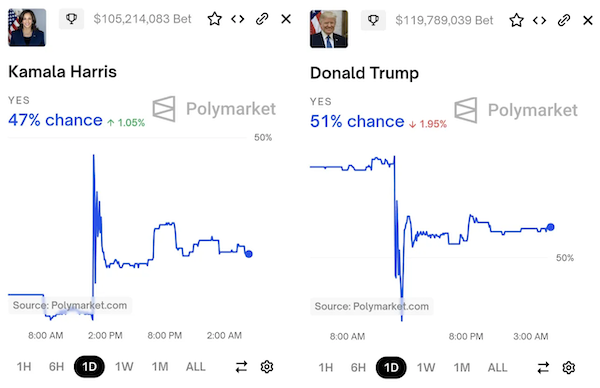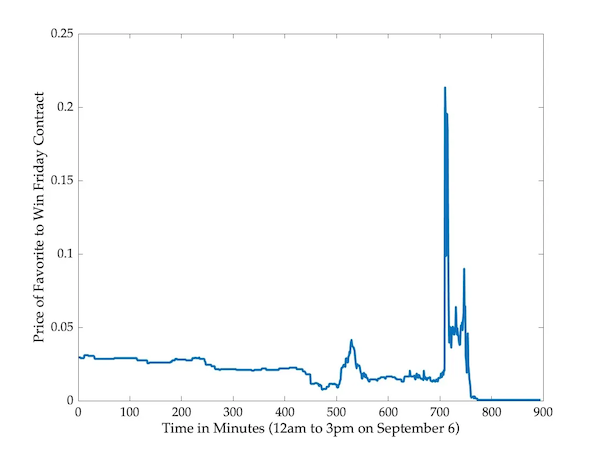A Failed Attempt at Market Manipulation

There are now several statistical models and prediction markets generating forecasts for the upcoming presidential election, and they point to a very close race. Harris has the edge in the FiveThirtyEight forecast and on PredictIt, but is behind in the Silver Bulletin forecast and on Polymarket. The Economist has the race essentially tied.
Some political scientists argue that these forecasts are quite meaningless, that it will take decades if not centuries to accumulate enough data to convincingly establish that they are more accurate than naive coin flips. I disagree with this assessment, but it’s certainly true that models and markets both have some serious limitations. Models are built and calibrated based on historical outcomes and run into deep trouble if we enter uncharted waters. And markets are subject to overreaction and manipulation.
There was a spectacular attempt at manipulation on Polymarket yesterday, and you can see evidence of it in the following sharp price movements:

What happened was this. A group of traders bet heavily on Harris and against Trump in an attempt to push her into the lead for a couple of hours. The sums involved were quite large, with one trader alone wagering about 2.5 million dollars. The goal was to ensure that the Harris contract would have the higher price for a majority of minutes during the three hour period between noon and 3pm EST on Friday, in order to profit from a derivative market that referenced prices in the primary market.
Specifically, the market Favorite to win on Polymarket on Friday listed contracts that would pay a dollar if Harris was ahead for a majority of the 180 minutes in the referenced period. These contracts were trading at about three cents at the start of the day, but would rise to above 20 cents at around the beginning of the three hour window:

One trader spent over 11,000 dollars buying these contracts at an average price of 8 cents each, accumulating around 140,000 contracts. Had the attempt at manipulation been successful, there would have been a gain of about 130,000 dollars. This would have been offset by losses in the primary markets, assuming that the prices would have returned to pre-manipulation levels. Even so, it looks like a six-figure profit in a single day on a 2.5 million dollar investment would have been secured.
Despite the fact that the attempt failed, most of the amounts spent in the primary market were recoverable. The would-be manipulators lost a few thousand dollars, but nowhere near the millions that they wagered in executing the plan.
Andrew Gelman argues that such manipulation is tantamount to “interfering with democracy.” And you can see his point, since beliefs about election outcomes can be self-fulfilling. Pessimism about the viability of a candidate results in lower morale, fundraising, volunteer effort, and turnout by supporters, all of which make defeat objectively more likely.
Markets that reference prices in other markets are common in the world of finance of course—all stock options and index futures have this property. But when it comes to electoral prediction markets, I see no rationale for such derivative contracts. They serve no legitimate purpose and open up rather obvious strategies for manipulation. And even if attempts at manipulation fail in the end, they still arouse suspicion and sow confusion.
Derivative contracts of this kind continue to be listed on Polymarket. It would be a good thing if they were discontinued.
Source link
